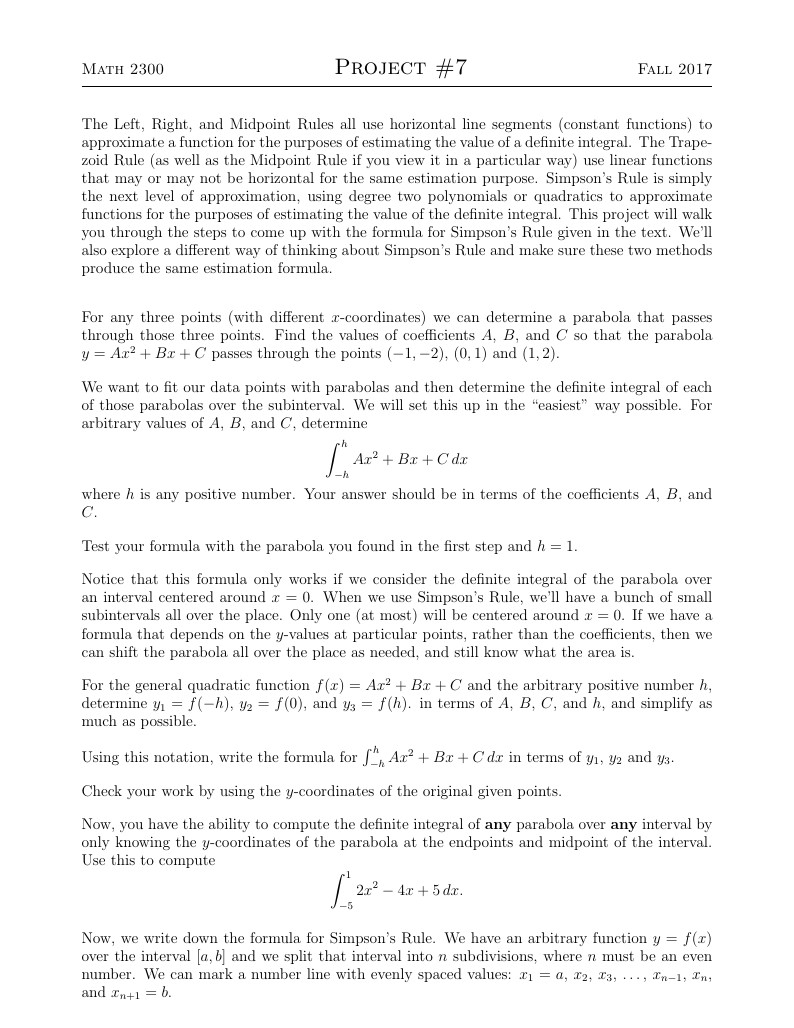
FSU-MATH2300-Project7
作者:
Sarah Wright
最近上传:
8 年前
许可:
Creative Commons CC BY 4.0
摘要:
The last project in Calculus 1 at Fitchburg State. Students work through steps to develop two different formulations of Simpson's Rule for estimating integrals.

The last project in Calculus 1 at Fitchburg State. Students work through steps to develop two different formulations of Simpson's Rule for estimating integrals.

\documentclass[12pt]{amsart}
\addtolength{\hoffset}{-2.25cm}
\addtolength{\textwidth}{4.5cm}
\addtolength{\voffset}{-2.5cm}
\addtolength{\textheight}{5cm}
\setlength{\parskip}{0pt}
\setlength{\parindent}{15pt}
\usepackage{amsthm}
\usepackage{amsmath}
\usepackage{amssymb}
\usepackage[colorlinks = true, linkcolor = black, citecolor = black, final]{hyperref}
\usepackage{graphicx}
\usepackage{multicol}
\usepackage{ marvosym }
\newcommand{\ds}{\displaystyle}
\pagestyle{myheadings}
\setlength{\parindent}{0in}
\pagestyle{empty}
\begin{document}
\thispagestyle{empty}
{\scshape Math 2300} \hfill {\scshape \Large Project \#7} \hfill {\scshape Fall 2017}
\medskip
\hrule
\bigskip
\bigskip
The Left, Right, and Midpoint Rules all use horizontal line segments (constant functions) to approximate a function for the purposes of estimating the value of a definite integral. The Trapezoid Rule (as well as the Midpoint Rule if you view it in a particular way) use linear functions that may or may not be horizontal for the same estimation purpose. Simpson's Rule is simply the next level of approximation, using degree two polynomials or quadratics to approximate functions for the purposes of estimating the value of the definite integral. This project will walk you through the steps to come up with the formula for Simpson's Rule given in the text. We'll also explore a different way of thinking about Simpson's Rule and make sure these two methods produce the same estimation formula.
\bigskip
\bigskip
For any three points (with different $x$-coordinates) we can determine a parabola that passes through those three points. Find the values of coefficients $A$, $B$, and $C$ so that the parabola $y = Ax^2 + Bx + C$ passes through the points $(-1, -2)$, $(0, 1)$ and $(1, 2)$.
\bigskip
We want to fit our data points with parabolas and then determine the definite integral of each of those parabolas over the subinterval. We will set this up in the ``easiest" way possible. For arbitrary values of $A$, $B$, and $C$, determine $$\int_{-h}^h Ax^2 + Bx + C\,dx$$ where $h$ is any positive number. Your answer should be in terms of the coefficients $A$, $B$, and $C$.
\bigskip
Test your formula with the parabola you found in the first step and $h = 1$.
\bigskip
Notice that this formula only works if we consider the definite integral of the parabola over an interval centered around $x = 0$. When we use Simpson's Rule, we'll have a bunch of small subintervals all over the place. Only one (at most) will be centered around $x = 0$. If we have a formula that depends on the $y$-values at particular points, rather than the coefficients, then we can shift the parabola all over the place as needed, and still know what the area is.
\bigskip
For the general quadratic function $f(x) = Ax^2 + Bx + C$ and the arbitrary positive number $h$, determine $y_1= f(-h)$, $y_2 = f(0)$, and $y_3=f(h)$. in terms of $A$, $B$, $C$, and $h$, and simplify as much as possible.
\bigskip
Using this notation, write the formula for $\int_{-h}^h Ax^2 + Bx + C\,dx$ in terms of $y_1$, $y_2$ and $y_3$.
\bigskip
Check your work by using the $y$-coordinates of the original given points.
\bigskip
Now, you have the ability to compute the definite integral of {\bf any} parabola over {\bf any} interval by only knowing the $y$-coordinates of the parabola at the endpoints and midpoint of the interval. Use this to compute $$\int_{-5}^1 2x^2 - 4x + 5\,dx.$$
\bigskip
Now, we write down the formula for Simpson's Rule. We have an arbitrary function $y = f(x)$ over the interval $[a,b]$ and we split that interval into $n$ subdivisions, where $n$ must be an even number. We can mark a number line with evenly spaced values: $x_1 = a$, $x_2$, $x_3$, \dots , $x_{n-1}$, $x_n$, and $x_{n+1} = b$.
\bigskip
Consider the first pair of subintervals, so the interval $[x_1, x_3]$, and use your work above to estimate $$\int_{x_1}^{x_3} f(x)\,dx.$$ You may use $y_i = f(x_i)$ if that makes things easier on you.
\bigskip
Now, do the same thing for every pair of subintervals all the way from $a$ to $b$ so that you have an estimate of $$\int_a^b f(x)\,dx.$$
This formula should look like the formula for Simpson's Rule found in the textbook.
\bigskip
\bigskip
Write out similar formulas for the Trapezoid Rule and the Midpoint Rule using the same notation for the subintervals and taking pairs of those subintervals together. So you'll have $x$-values from $a = x_1$ to $b = x_{n+1}$, and $n$ separate subintervals, but each rectangle or trapezoid will consist of two of these subintervals together.
\bigskip
The error bound formula for the Trapezoid Rule is found in the textbook, and there is a similar one for the Midpoint Rule. Look up that formula somewhere and explain it here.
\bigskip
Describe the types of functions where the Trapezoid Rule is an overestimate. In these cases, does the Midpoint Rule give an over or underestimate? Explain.
\bigskip
What if the Trapezoid Rule provides an underestimate? What can you say about the Midpoint Rule?
\bigskip
Use these observations as well as the error bound formulas to explain why one might consider the quantity $$\frac{1}{3}T_n + \frac{2}{3}M_n.$$
\bigskip
Use the formulas for all three rules to show that in addition to being the quadratic approximation, Simpson's Rule is also the above weighted average of the Midpoint and Trapezoid Rules.
\bigskip
COOL, RIGHT?!?!?!?!?!?!?
\end{document}